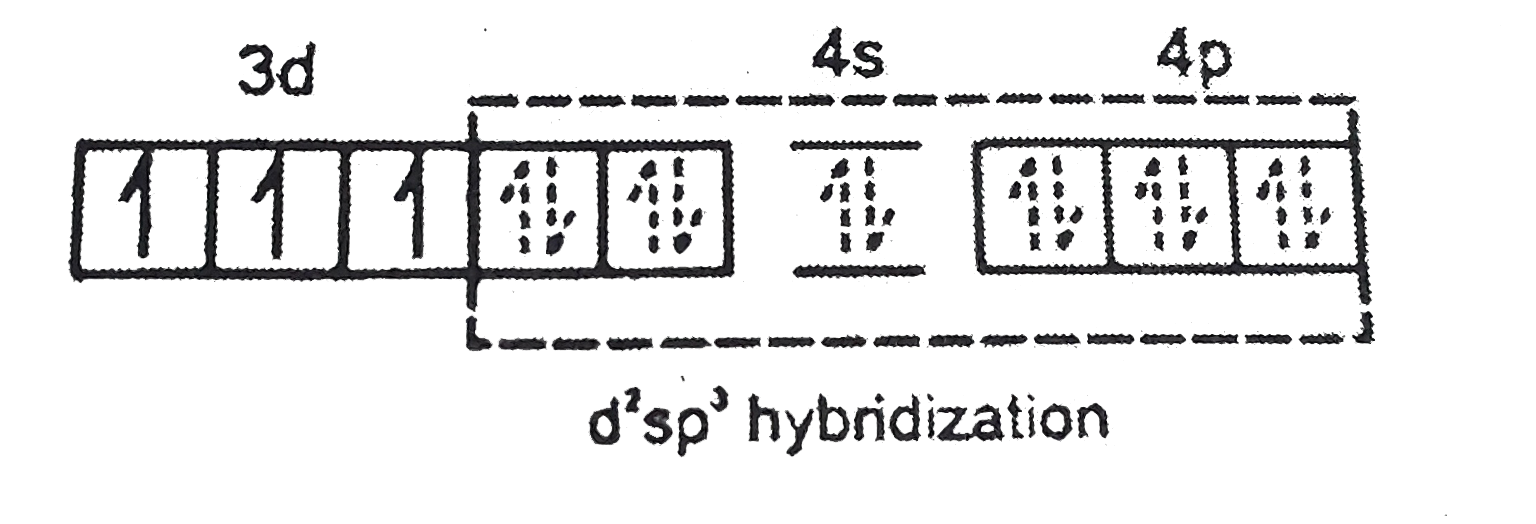A metal complex having composition Cr(NH3)4CI2Br has been isolated in two forms A and B. The form A reacts with AgNO3 to give a white precipitate readily soluble in dilute aqueous ammonia whereas B gives a pale yellow precipitate soluble in concentrated ammonia.
(i) Write the formulae of isomers A and B.
(ii) State the hybridisation of chromium in each of them.
(iii) Calculate the magnetic moment (spin only) of the isomer A.
(i)[Cr(NH3)4ClBr]Claq⇐⇒[Cr(NH3)4ClBr]++Cl−,Ag++Cl−→AgCl⏐⏐↓(white), soluble in dilute NH3.
[Cr(NH3)4Cl2]Braq⇐⇒[Cr(NH3)4Cl2]++Br−,Ag++Br−→AgBr⏐⏐↓(yellow), soluble in conc. NH3. So , A=[Cr(NH3)4ClBr]ClandB=[Cr(NH3)4Cl2]Br.
(ii) In both complexes chromium is in +3 oxidation state. Chromium with 3d3 configuration has 3 unpaired electrons with weak field as well as strong field as well as strong field ligand. So, the hybridisation scheme is as follow :

(iii) μ=√n(n+2)=√15
(iv) EAN=24-3+12=22
(v) Yes, both have two ions per formula unit.
(vi)AgCl+2NH3⇔[Ag(NH3)2]Cl,AgBr+2NH3⇔[Ag(NH3)2]Br
Topper's Solved these Questions
- COORDINATION COMPOUNDSBOOK - RESONANCE ENGLISHCHAPTER - COORDINATION COMPOUNDSEXERCISE - Exercise Part-I: Subjective Question Section (E)
5 Videos
- COORDINATION COMPOUNDSBOOK - RESONANCE ENGLISHCHAPTER - COORDINATION COMPOUNDSEXERCISE - Exercise Part-I: Subjective Question Section (F)
3 Videos
- COORDINATION COMPOUNDSBOOK - RESONANCE ENGLISHCHAPTER - COORDINATION COMPOUNDSEXERCISE - Exercise Part-I: Subjective Question Section (C)
4 Videos
- CHEMISTRY IN EVERYDAY LIFEBOOK - RESONANCE ENGLISHCHAPTER - CHEMISTRY IN EVERYDAY LIFEEXERCISE - ORGANIC CHEMISTRY(Chemistry in every day life)
31 Videos
- D & F BLOCK ELEMENTSBOOK - RESONANCE ENGLISHCHAPTER - D & F BLOCK ELEMENTSEXERCISE - ORGANIC CHEMISTRY(Aldehydes , Ketones, Carboxylic acid)
15 Videos
Similar Questions
AgNO3 solution will not give white precipitate with
View SolutionAmmonia/ammonium ion gives yellow precipitate with:
View SolutionCCl4 gives a white precipitate when treated with AgNO3.
View SolutionNaBr gives pale yellow precipitate with AgNO3 solution but CBr4 does not. Why ?
View SolutionWhich one of the following will give a white precipitate with AgNO3 in aqueous medium ?
View SolutionAn octahedral complex with molecular composition M.5NH3.Cl.SO4 has two isomers. A and B. The solution A gives a white precipitation with AgNO3 solution and the solution of B gives white precipitate with BaCl2 solution. The type of isomerism exhibited by the complex is :
View SolutionCoSO4Cl.5NH3 exists in two isomeric forms 'A' and 'B'. Isomer 'A' reacts with AgNO3 to give white precipitate, but does not react with BaCl2. Isomer 'B' gives white precipitate with BaCl2 but does not react with AgNO3. Answer the following questions.
(a) Identify 'A' and 'B' and write their structural formulae.
(b) Name the type of isomerism involved.
(c) Give the IUPAC name of 'A' and 'B'.
View SolutionA metal chloride original solution (i.e.O.S) on mixing with
K2CrO4 solution gives a yellow precipitate soluble in aqueous
sodium hydroxide. The metal may be :
View SolutionA solution of a salt in water, on addition of dilute HCI, gives a white precipitate, which is soluble in hot water. The salt contains
View SolutionStatement-1:White precipitate of zinc phosphate is soluble in Ammonia.
Statement-2:Zinc phosphate forms a soluble complex with ammonia.
View Solution
